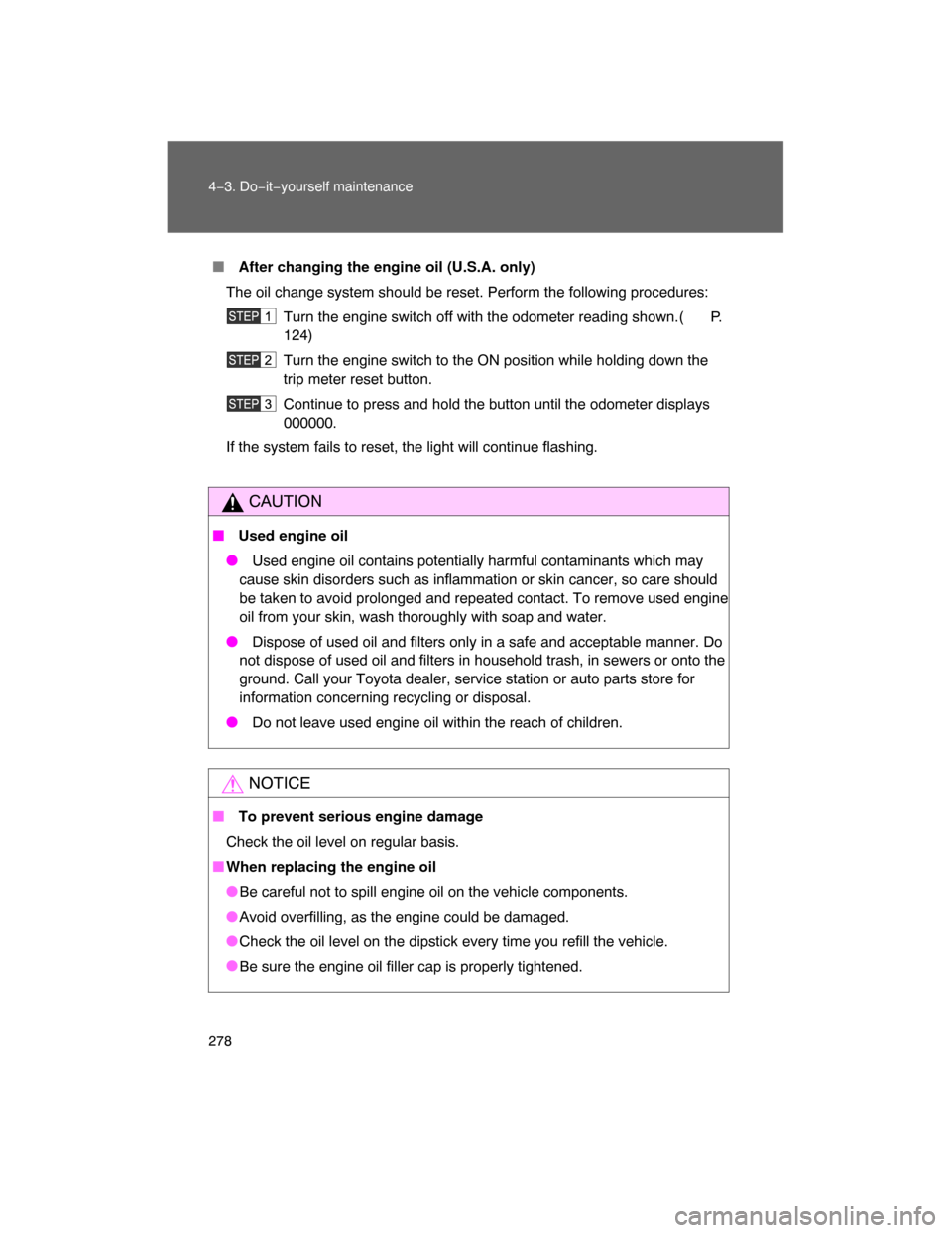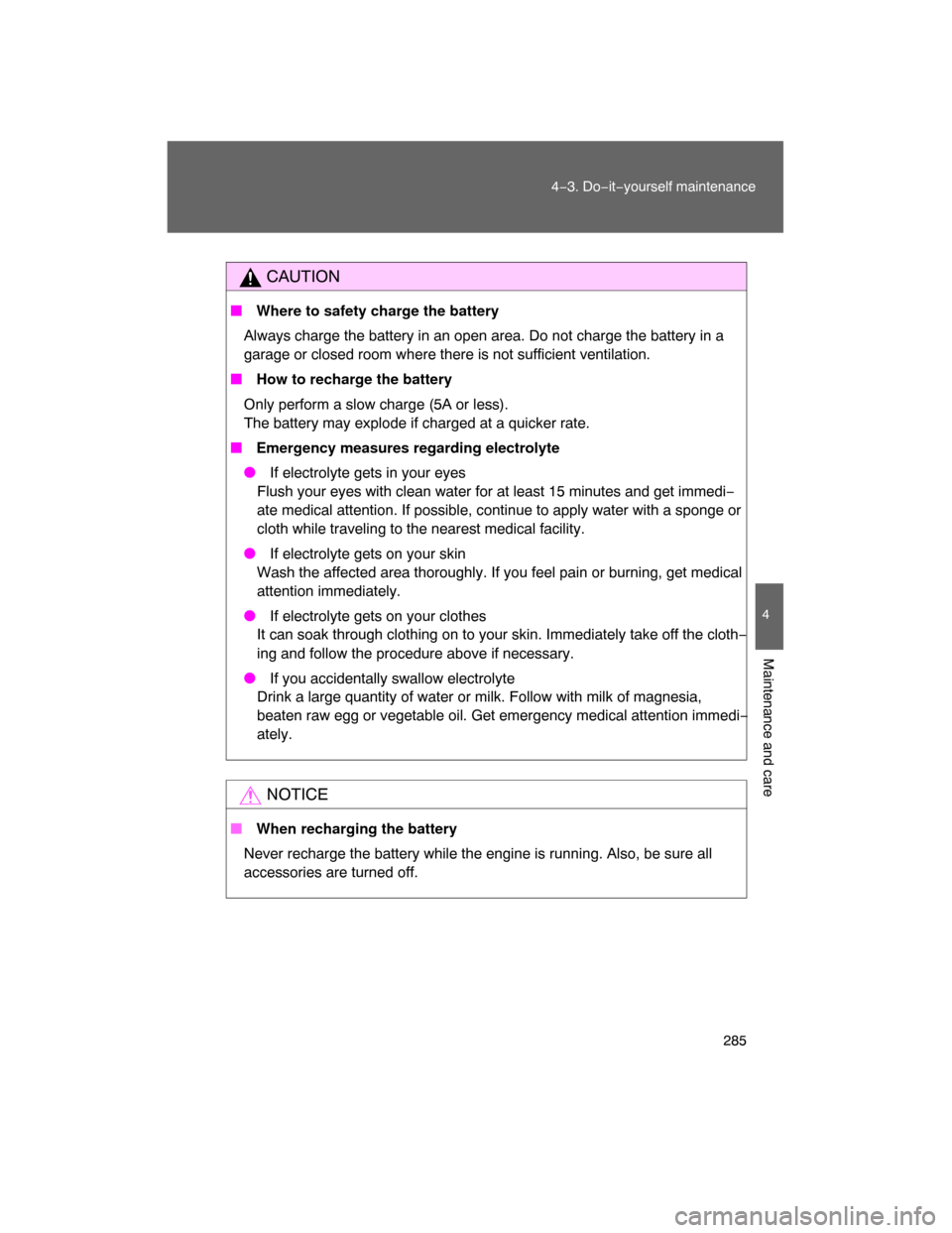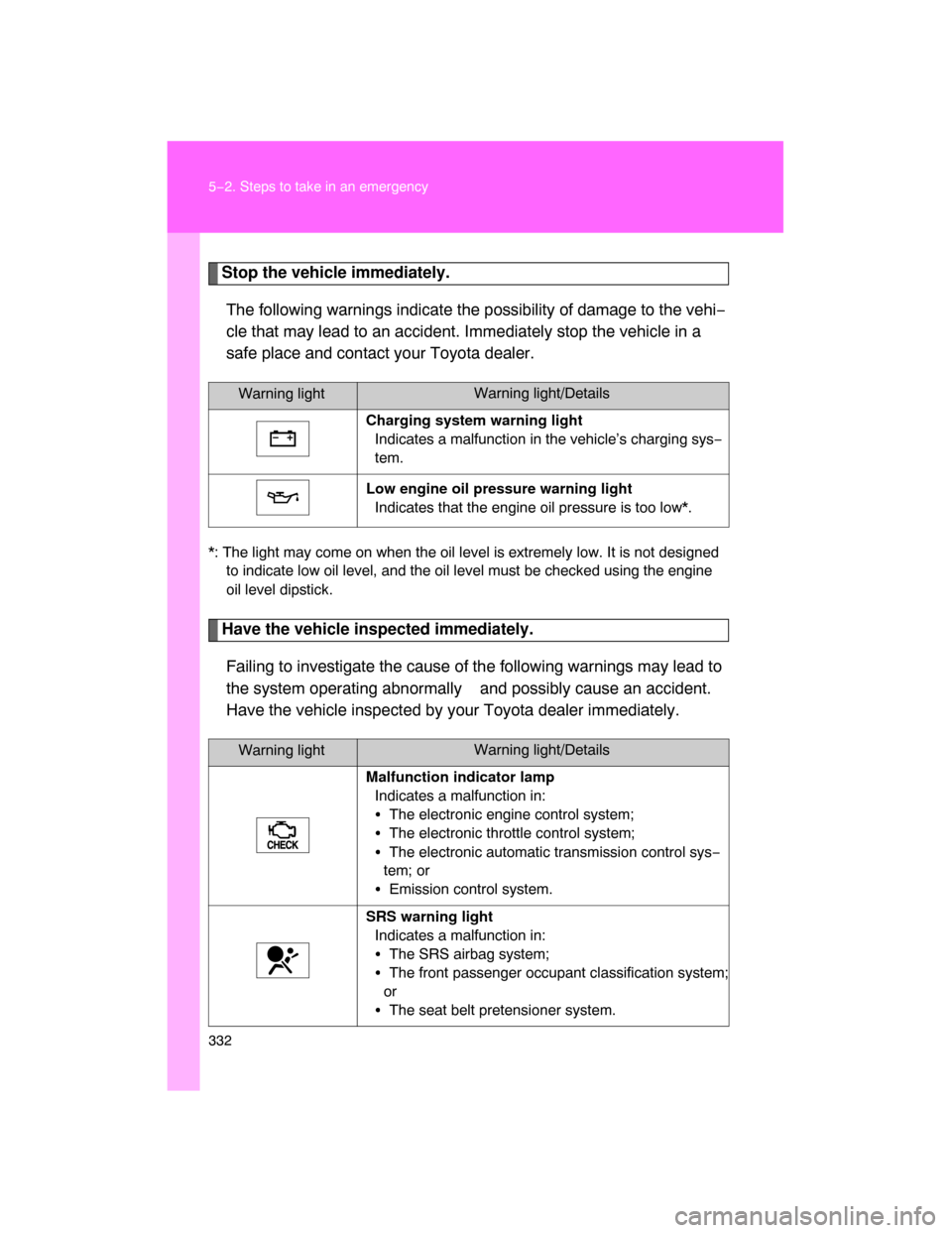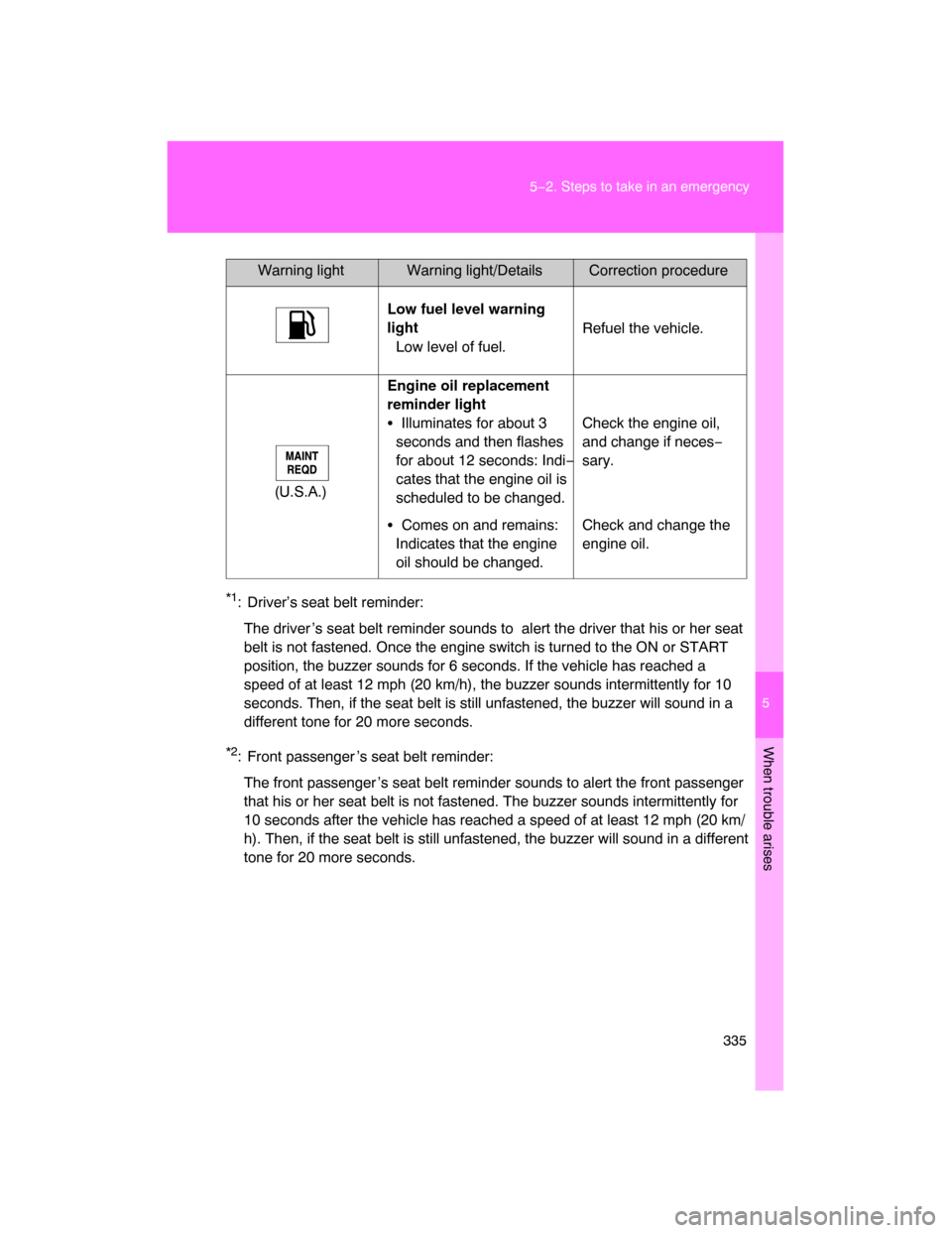Page 270 of 400
274
4−3. Do−it−yourself maintenance
Engine compar tment
Washer fluid tank (P. 286)
Power steering fluid reservoir
(P. 282)
Radiator cap
Engine oil level dipstick
(P. 275)
Engine coolant reservoir
(
P. 279)Engine oil filler cap
(P. 275)
Brake fluid reservoir
(P. 280)
Fuse box (
P. 303)
Battery (
P. 283)
Condenser ( P. 280)
Radiator (P. 280)
5214
910
6873
Page 271 of 400
275
4−3. Do−it−yourself maintenance
4
Maintenance and care
Engine oil
With the engine at operating temperature and turned off, check the oil
level on the dipstick.
� Checking the engine oil
Park the vehicle on level gro und. After turning off the engine,
wait a few minutes for the oil
to drain back into the bottom of
the engine.
Hold a rag under the end and
pull the dipstick out.
Wipe the dipstick clean.
Reinsert the dipstick fully.
Holding a rag under the end, pull the dipstick out and check
the oil level.
Wipe the dipstick and reinsert it fully.
Low
Full
Page 272 of 400
276 4−3. Do−it−yourself maintenance
� Adding engine oil
If the oil level is below or near
the low level mark, add engine
oil of the same type as already in
the engine.
Make sure to check the oil type and prepare the items needed before
adding oil.
Remove the oil filler cap, turning it counterclockwise.
Add engine oil slowly.
Checking the dipstick.
Reinstall the filler cap, turning it clockwise.
The approximate quantity of oil needed to raise the level between low and
full on the dipstick is indicated as follows:
1.6 qt. (1.5 L, 1.3 lmp. qt.)
�
Recommended viscosity
SAE 5W−30 is the best choice for
good fuel economy, and good
starting in cold weather.
*: If SAE 5W−30 oil is not avail−
able, SAE 10W−30 oil may be
used. However, it should be
replaced with SAE 5W−30 at
the next oil change.
Oil grade ILSAC multigrade engine oil
Items Clean funnel
Outside temperature
Page 273 of 400
277
4−3. Do−it−yourself maintenance
4
Maintenance and care
� How to read oil container labels
Some oil containers are labeled with ILSAC certification marks that
help you to select the proper oil.
� Engine oil consumption
� The amount of engine oil consumed depends on the oil viscosity, the
quality of the oil and the way the vehicle is driven.
�More oil is consumed under driving conditions such as high speeds and
frequent acceleration and deceleration.
� A new engine consumes more oil.
�When judging the amount of oil consumption, keep in mind that the oil
may have become diluted, making it difficult to judge the true level accu−
rately.
� Oil consumption: Max. 1.1 qt./600 miles, 0.9 lmp.qt./600 miles (1.0 L per
1000 km)
�If you consume more than 1.1 qt. (1.0 L, 0.9 lmp.qt.) every 600 miles
(1000 km), contact your Toyota dealer.
Page 274 of 400

278 4−3. Do−it−yourself maintenance
� After changing the engine oil (U.S.A. only)
The oil change system should be reset. Perform the following procedures:
Turn the engine switch off with the odometer reading shown.( P.
124)
Turn the engine switch to the ON position while holding down the
trip meter reset button.
Continue to press and hold the button until the odometer displays
000000.
If the system fails to reset, the light will continue flashing.
CAUTION
� Used engine oil
� Used engine oil contains potentially harmful contaminants which may
cause skin disorders such as inflammation or skin cancer, so care should
be taken to avoid prolonged and repeated contact. To remove used engine
oil from your skin, wash thoroughly with soap and water.
� Dispose of used oil and filters only in a safe and acceptable manner. Do
not dispose of used oil and filters in household trash, in sewers or onto the
ground. Call your Toyota dealer, service station or auto parts store for
information concerning recycling or disposal.
� Do not leave used engine oil within the reach of children.
NOTICE
� To prevent serious engine damage
Check the oil level on regular basis.
�When replacing the engine oil
�Be careful not to spill engine oil on the vehicle components.
�Avoid overfilling, as the engine could be damaged.
�Check the oil level on the dipstick every time you refill the vehicle.
�
Be sure the engine oil filler cap is properly tightened.
Page 281 of 400

285
4−3. Do−it−yourself maintenance
4
Maintenance and care
CAUTION
� Where to safety charge the battery
Always charge the battery in an open area. Do not charge the battery in a
garage or closed room where there is not sufficient ventilation.
� How to recharge the battery
Only perform a slow charge (5A or less).
The battery may explode if charged at a quicker rate.
� Emergency measures regarding electrolyte
� If electrolyte gets in your eyes
Flush your eyes with clean water for at least 15 minutes and get immedi−
ate medical attention. If possible, continue to apply water with a sponge or
cloth while traveling to the nearest medical facility.
� If electrolyte gets on your skin
Wash the affected area thoroughly. If you feel pain or burning, get medical
attention immediately.
� If electrolyte gets on your clothes
It can soak through clothing on to your skin. Immediately take off the cloth−
ing and follow the procedure above if necessary.
� If you accidentally swallow electrolyte
Drink a large quantity of water or milk. Follow with milk of magnesia,
beaten raw egg or vegetable oil. Get emergency medical attention immedi−
ately.
NOTICE
� When recharging the battery
Never recharge the battery while the engine is running. Also, be sure all
accessories are turned off.
Page 327 of 400

332 5−2. Steps to take in an emergency
Stop the vehicle immediately.
The following warnings indicate the possibility of damage to the vehi−
cle that may lead to an accident. Immediately stop the vehicle in a
safe place and contact your Toyota dealer.
*: The light may come on when the oil level is extremely low. It is not designed
to indicate low oil level, and the oil level must be checked using the engine
oil level dipstick.
Have the vehicle inspected immediately.
Failing to investigate the cause of the following warnings may lead to
the system operating abnormally
and possibly cause an accident.
Have the vehicle inspected by your Toyota dealer immediately.
Warning lightWarning light/Details
Charging system warning light
Indicates a malfunction in the vehicle’s charging sys−
tem.
Low engine oil pressure warning light
Indicates that the engine oil pressure is too low*.
Warning lightWarning light/Details
Malfunction indicator lamp
Indicates a malfunction in:
�The electronic engine control system;
�The electronic throttle control system;
�The electronic automatic transmission control sys−
tem; or
�Emission control system.
SRS warning light
Indicates a malfunction in:
�The SRS airbag system;
�The front passenger occupant classification system;
or
�The seat belt pretensioner system.
Page 330 of 400

5
When trouble arises
335 5−2. Steps to take in an emergency
*1: Driver’s seat belt reminder:
The driver ’s seat belt reminder sounds to alert the driver that his or her seat
belt is not fastened. Once the engine switch is turned to the ON or START
position, the buzzer sounds for 6 seconds. If the vehicle has reached a
speed of at least 12 mph (20 km/h), the buzzer sounds intermittently for 10
seconds. Then, if the seat belt is still unfastened, the buzzer will sound in a
different tone for 20 more seconds.
*2: Front passenger ’s seat belt reminder:
The front passenger ’s seat belt reminder sounds to alert the front passenger
that his or her seat belt is not fastened. The buzzer sounds intermittently for
10 seconds after the vehicle has reached a speed of at least 12 mph (20 km/
h). Then, if the seat belt is still unfastened, the buzzer will sound in a different
tone for 20 more seconds.Low fuel level warning
light
Low level of fuel.Refuel the vehicle.
(U.S.A.)Engine oil replacement
reminder light
�Illuminates for about 3
seconds and then flashes
for about 12 seconds: Indi−
cates that the engine oil is
scheduled to be changed.Check the engine oil,
and change if neces−
sary.
�Comes on and remains:
Indicates that the engine
oil should be changed.
Check and change the
engine oil.
Warning lightWarning light/DetailsCorrection procedure